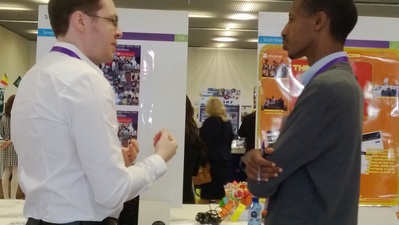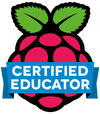|
26/3/2014 Using QR codes in the classroomWhat is a QR code? A QR code (short for Quick Response Code) is a machine-readable code made up of black and white squares. Example of a QR code: QR codes are designed to enhance printed material such as: books, magazines, programmes and guides or even displays at museums and heritage sites. Using an array of free apps and online tools, you can quickly and easily create your very own multimedia-rich QR experiences which can be triggered from a web enabled device. Suggestions for using QR codes in the Classroom: General:
Science:
Geography/History:
Art:
Examples: Interactive eSafety wall display Students create a revision resource using QR codes Using QR Codes in the Classroom What you will need for creating your own QR experience
1. A web enabled device with built in camera (e.g. tabet, netbook or smart phone) 2. QR creation tool
3. QR reader
Instructions 1. Install and load your preferred QR creation tool. 2. Paste in the URL of the website or content you wish to trigger from your QR code. 3. Print out the automatically generated QR codes. 4. Install and run your preferred QR reader. 5. Point your devices camera at your newly created QR code. 6. Have fun! Please let me know how you are using QR Codes in your classroom! I was recently lucky enough to be invited to attend the Microsoft in Education Global Forum held in Barcelona. This annual event aims to recognize and celebrate the achievements of educators who are preparing students for life in the 21st century. Each year, Microsoft brings together participants from the Microsoft Innovative Educators Program and the Microsoft Innovative Schools Program for an energetic, collaborative conference. This high profile event is attended by more than 1000 of the world’s most innovative educators, school leaders, and education leaders from 75 countries, along with government officials. Rather than provide a day-by-day account of the Global Forum, for this you can check out the excellent blogs from other expert educators (David Rogers, David Renton, Nikki Cooper & Ray Chambers) I would however, like to reflect on what I have learnt as a result of attending the global forum and emphasize some of the key points and highlights of the whole experience. May I start by saying that I felt honored to be chosen as one of 10 educators to represent the UK at the Microsoft in Education Global Forum and privileged to part of a 250 strong delegation of expert educators from around the world. I would also like to say, as other expert educators have expressed, that I felt humbled having met some of the other educators from around the world and having witnessed the profound impact others are making both locally and globally through their projects, and in some cases, with access to little or limited technology. 2014 Global Forum - Recap video: Can you spot a cameo from me? Highlights A major theme of the Global Forum was the exhibition. This gave the expert educators an opportunity to showcase their learning activities. However, If I have one criticism of the forum, it would be the lack of time to discuss with other educators about their projects. Prepare to be judged – A last-gasp attempt to explain to the judges the merits of my project Of the projects I did have chance to see, one of my favourites was an entry from the Ukraine called “Folk Tales”. The premise was simple - Students find out about folk tales from their region, present them in pictures or in other creative form, retell them and translate into English. They then share their creations online. Students, from other countries, then view the uploaded materials and try to reinterpret the story from the material. The students then upload their interpretation of the story to the Internet and compare it to the original tale. Another highlight of the event was Anthony Salcito’s (Worldwide Vice President for Microsoft Education) keynote. In his keynote, Anthony reminded us of the vital role we play as teachers and referred to us as heroes and champions, in his eyes, for the work that we do to educate the young people of today! Also in his keynote, Anthony highlighted some examples of the innovative use of technology to support teaching and learning. Probably the most memorable example was a project called “Mystery Skype”. Anthony also used his keynote to showcase a number new tools to use in the classroom. Some of the highlights included: Project Spark – Best described as Kodu for grown-ups. Project Spark builds on the success of Kodu by offering the same easy to use event-driven programming interface however, takes Kodu to the next level with its stunning 3D graphics and downloadable additional content. Find out more about Project Spark here: Project Spark Un-named add-in for PowerPoint – Although I’m not at liberty to say much about this new future enhancement for PowerPoint however, what I can say is, it will completely change the way in which we use PowerPoint! OneNote – Now available free for Mac, OneNote continues, in my opinion, to be one of the most powerful tools for educators. With OneNote, teachers can organize their thoughts or plan their lessons and access these quickly and easily via a simple search. Teachers and students can communicate with one another and collaborate on projects (Perfect for Project-Based-Learning). The teacher can also collate notes at the end of each lesson or keep notes on individual students or each of their classes. ClassPolicy - A free classroom management solution for Windows 8 devices. With ClassPolicy, teachers can eliminate distractions by restricting web and application access, orchestrate their classes by automating the sequence of their lessons, gauge understanding by using quick polls. Whilst on the topic of useful tools to support teaching and learning, I must also mention our very own Stuart (App Man) Ball and his presentation on his favourite apps for Windows 8 devices. Most notable: ChronoZoom – An online interactive timeline for visualizing history. Project Siena – A Windows 8 app that lets you easily create your own Windows business apps in minutes. Click here to find out more. CreateBook – Allows you to easily create interactive ebooks for Windows 8 devices. NovaMind Mind Mapping – A complete Mind Mapping tool for Windows 8 devices. To find out more about educational apps for Windows 8 devices, visit Stuart Ball’s blog: Windows 8 Appedagogy Probably the most rewarding part of the week was meeting with other educators from around the world and sharing best practice. This started with the learn-a-thon. The Learn-a-thon The idea behind the learn-a-thon was to unite expert educators from different countries and challenge them to develop a project which addresses one of three topics (Sustainability, poverty and gender equality) and which encapsulated the concepts of 21 Century Design. Our project was on sustainability and involved students creating apps and online community (blog / wiki etc.) encouraging others to recycle and conserve our natural resources! Although I was a little skeptical at first, I found the process very rewarding. Not only did I learn the true power of Bing Translate for resolving the language divide, I also made a few new friends. An animated pitch from yours truly on sustainability The sharing of best practice was epitomized when David Rogers kindly offered to host a European TeachMeet in which, over a few light refreshments, educators from all over Europe showcased how they are using technology to enhance teaching and learning. This wasn't the first time I heard of the idea of TeachMeets however, this was the time I had attended one. I can honestly say that I really enjoyed the experience and will be investigating the possibility of arranging a TeachMeet in my area in the near future!
Key reflections As well as the usual meeting and greeting, there was also opportunity to hear keynotes from respected and influential educators from around the world. Here are some of the key points: “It's OK to let student's fail!” – As educators, it is OK to let our students fail however, we must also ensure that we enable our students to reflect and learn from their mistakes. “Teachers are control freaks we need to let go of the control and let students lead with technology”. – It is easy to underestimate the ability of our students and have pre-conceptions of what they are able achieve. If there is one thing I have learned as a result of my project, it’s that, as teachers, we sometimes need to stake a step back and allow our students to take ownership of their own learning – try, you might just be amazed at what your students are really capable of if you give them the chance! “Learning has changed - Your students are learning without you”. – With the Internet being more accessible than ever and with an abundance of online tools and resources to support independent learning, our students are learning outside of the classroom. This is no more evident than in the teaching of computer science with many students learning to code online using online tutorials such as those found on YouTube. As educators, we can take advantage of these resources and use them to flip our classrooms. To find out more about the benefits of flipped learning or learn how to flip your classrooms, visit my blog: Make the most of your lessons – flip your classroom “Collaboration is key!” – Whether you are an educator or a learner, collaboration is an important aspect of learning. If you are new to the idea of collaborative learning or don’t know where to start, start by forming a collaboration with another teacher in your school. This could be a small project or a team teaching exercise. Once you have mastered the art of collaboration in a safe / familiar environment, initiate a collaborative project with a neighboring school or, if you’re feeling really adventurous, try collaborating with another educator online. Social networking tools such as Facebook, Twitter and Edmodo are great places to find other educators with similar interests / ideas. Why not also find out where your next / nearest TeechMeet is. TeechMeets are not only a great place to find new ideas and resources, they are also a place to meet other like minded educators in your local area. “Don’t make technology the star, make it a tool to create amazing learning experiences.” – A message I echo from Anthony Salcito. Pedagogy must come first, technology second. With the appropriate planning, technology can transform teaching and learning however, what technology cannot do is conceal poor planning / teaching! Things I would have liked to have seen!
Conclusion Despite the long days and limited supply of coffee, I can honestly say that I have returned home, not only with a plethora of new ideas and resources but also with a renewed enthusiasm. I have also made some new friends along the way, not forgetting of course Stuart Ball who, along with the rest of the UK team, I wish to thank for all their support! I would like to finish with a quote from Satya Nadella (Microsoft CEO) “I truly believe that if you are not learning new things, you stop doing great and useful things.” |
AuthorSimon Johnson Microsoft Innovative Educator Expert / MIE Trainer
Minecraft Cert. Educator / Global Mentor
CAS Master Teacher
Raspberry Pi Cert. Educator
Tickle Ambassador
Archives
April 2017
CategoriesAll App Creation Apps Computing Esafety Ipad Multimedia QR Social Media Web 2.0 Web 2.0 |
Search by typing & pressing enter












 RSS Feed
RSS Feed
